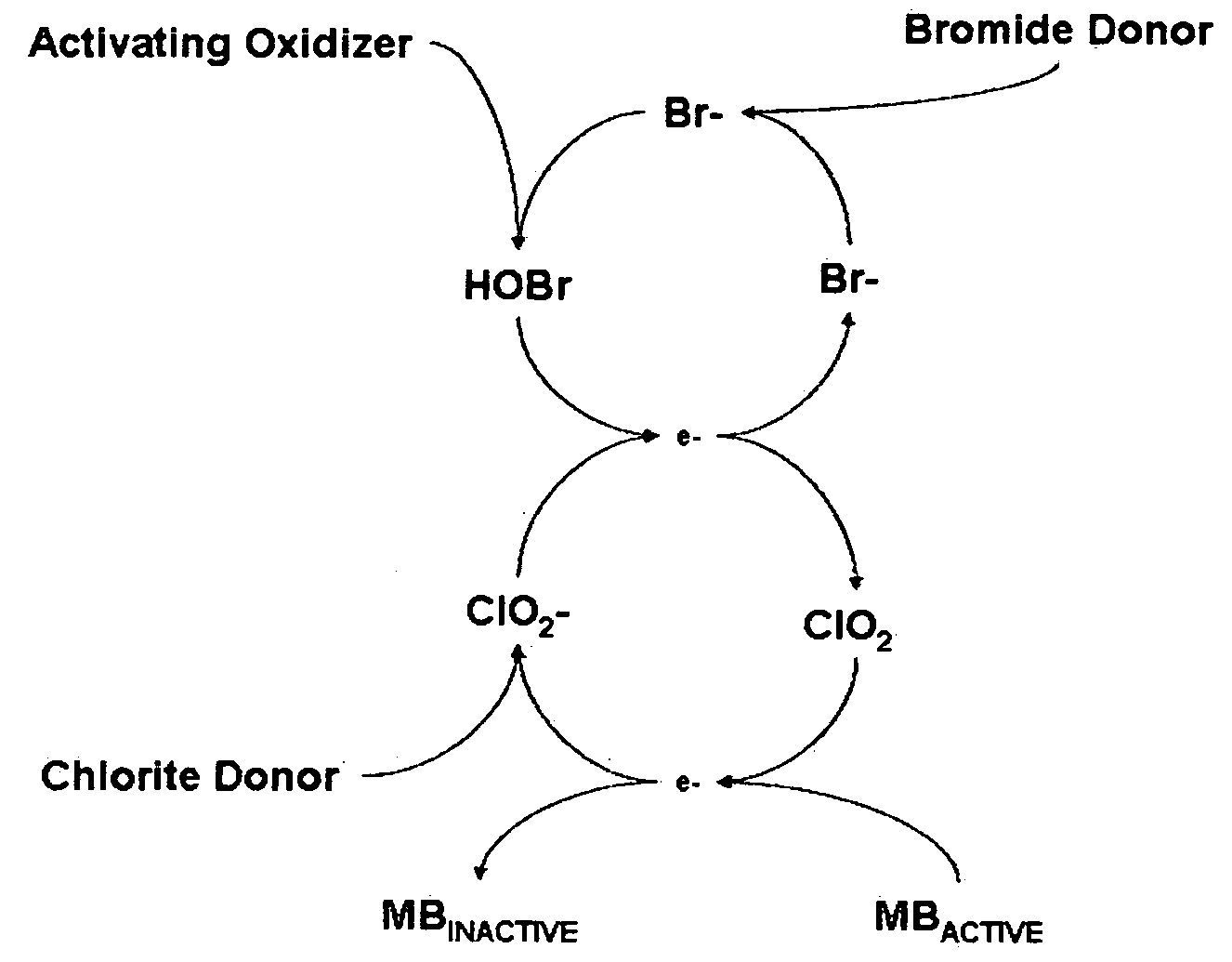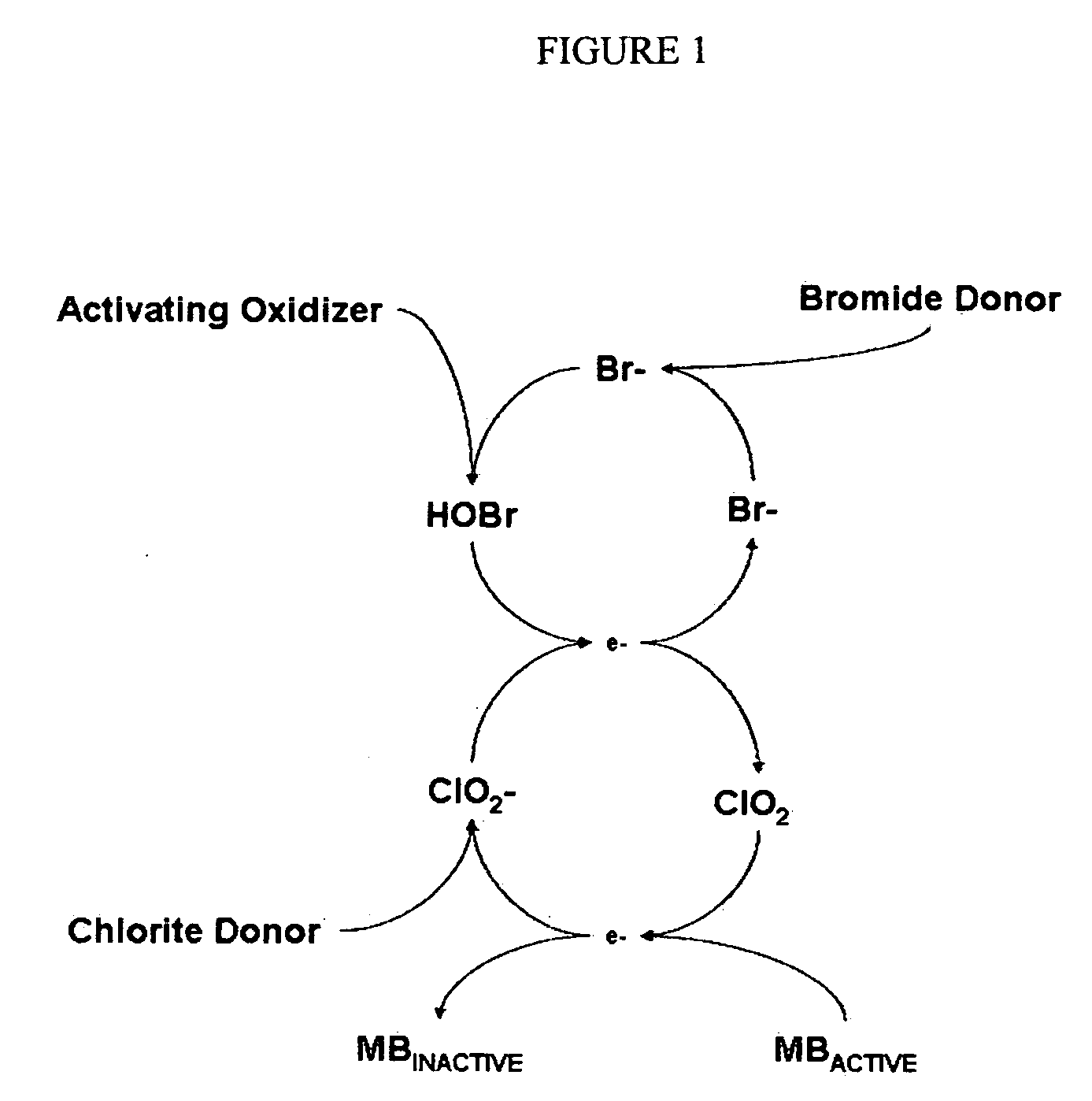Cyclic process for the efficient generation of chlorine dioxide in dilute solutions
a technology of chlorine dioxide and dilute solution, which is applied in the direction of metal/metal-oxide/metal-hydroxide catalyst, waste water treatment using complexing/solubilising chemicals, etc., can solve the problems of not providing effective regenerating chlorite anions and the use of chlorine dioxide generated by these priors, so as to achieve the effect of cost-effective and safe production of chlorine dioxide and efficient production of chlorine dioxid
- Summary
- Abstract
- Description
- Claims
- Application Information
AI Technical Summary
Benefits of technology
Problems solved by technology
Method used
Image
Examples
example 1
[0103]To 500 ml of city tap water, a 6% solution of sodium hypochlorite was added to achieve approximately 4.4 ppm as Cl2. From a stock solution of sodium chlorite, 1.14 ppm as ClO2− was added to the solution and the pH was adjusted using sodium bisulfate. At time equals 1 minute, the pH was 7.37. At time equals 10 minutes the pH was 7.44. A 25 ml sample was taken and treated with DPD followed by titration with thiosulfate standardized solution. Total Free measured approximately 4.6 ppm as Cl2. A 50 ml sample was taken and treated with Glycine followed by DPD and titrated with thiosulfate stnd solution. The result indicated 0.1 ppm as Cl2 of chlorine dioxide. The remainder of the treated solution was then treated with sodium bromide to obtain 20 ppm as Br−. The sample was treated with sodium bisulfate to stabilize the pH. After a lapsed time of 8 minutes, a 25 ml sample was taken and tested using DPD which indicated 4.0 ppm as Cl2. A 50 ml sample was taken a treated with glycine fol...
example 2
[0104]To 500 ml of city tap water, 0.08 grams sodium bicarbonate was added to buffer the pH. 100 ppb as CO2+ was added along with 100 ppm as Br— and 1.18 ppm as ClO2−. After 2 minutes of mixing with a magnetic stirrer, 24 ppm of potassium monopersulfate was added to the system. At time equals 3 minutes the pH was 7.26. At time equals 10 minutes the pH was 7.36. Two 25 ml samples were taken. Sample 1 was tested using DPD followed by KI which indicated a total free of 3.8 ppm as Cl2 and a total of 4.2 ppm as Cl2. Sample 2 was treated with glycine followed by DPD, the sample resulting in a chlorine dioxide of 1.2 ppm as Cl2.
Discussion of Examples
[0105]It is clearly evident that the efficiency of chlorine dioxide generation from chlorite anions at near neutral pH by converting bromide anions into hypobromous acid followed by conversion of dilute solutions of chlorite anions to chlorine dioxide is many times higher than that achieved by using hypochlorous acid. Also other oxidants such a...
PUM
| Property | Measurement | Unit |
|---|---|---|
| concentration | aaaaa | aaaaa |
| pH | aaaaa | aaaaa |
| concentrations | aaaaa | aaaaa |
Abstract
Description
Claims
Application Information
 Login to View More
Login to View More - R&D
- Intellectual Property
- Life Sciences
- Materials
- Tech Scout
- Unparalleled Data Quality
- Higher Quality Content
- 60% Fewer Hallucinations
Browse by: Latest US Patents, China's latest patents, Technical Efficacy Thesaurus, Application Domain, Technology Topic, Popular Technical Reports.
© 2025 PatSnap. All rights reserved.Legal|Privacy policy|Modern Slavery Act Transparency Statement|Sitemap|About US| Contact US: help@patsnap.com


